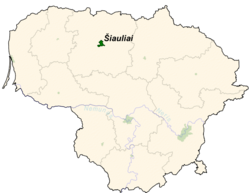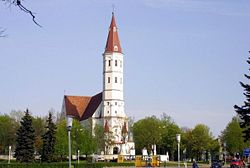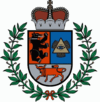Šiauliai
| Šiauliai | |||
| — City municipality — | |||
|
|||
| Nickname(s): Saulės miestas (The Sun City) | |||
 |
|||
| Coordinates: | |||
| Country | |||
|---|---|---|---|
| Ethnographic region | Samogitia | ||
| County | Šiauliai County | ||
| Municipality | Šiauliai city municipality | ||
| Capital of | Šiauliai County Šiauliai city municipality Šiauliai district municipality |
||
| First mentioned | 1236 | ||
| Granted city rights | 1589 | ||
| Elderships | Medelynas eldership, Rėkyva eldership | ||
| Area | |||
| - Total | 81 km² (31.3 sq mi) | ||
| Population (2007) | |||
| - Total | 128,396 | ||
| Time zone | EET (UTC+2) | ||
| - Summer (DST) | EEST (UTC+3) | ||
| Website: http://www.siauliai.lt | |||
Šiauliai (, IPA: /ʃoʊˈleı/, Samogitian: Šiaulē, Latvian: Saule (historic) and Šauļi (modern), German: Schaulen, Polish: Szawle, Russian: Шавли (historic) and Шяуля́й (modern)) is the fourth largest city in Lithuania, with a population of 129,075. It is the capital of Šiauliai County. Unofficially, the city is the capital of Northern Lithuania. It is served by Siauliai International Airport.
Contents |
History
The city was first mentioned in written sources as Soule in Livonian Order chronicles describing the battle of the Sun. Thus the city's founding date is now considered to be September 22, 1236, the same date when the battle took place, not far from Šiauliai. At first developed as a defense post against the raids by the Teutonic and Livonian Orders. After the battle of Grunwald in 1410, the raids stopped and Šiauliai started to develop as an agricultural settlement. In 1445, a wooden church was built. It was replaced in 1634 with the brick church which can be seen in the city center today.

Šiauliai was granted Magdeburg city rights in 1589. In the 16th century it became an administrative center of the area. However, in the 17th and 18th centuries the city was devastated by The Deluge and epidemics of the Bubonic plague.
The credit for the city's rebirth goes to Antoni Tyzenhaus (1733–1785) who after a violent revolt of peasants of the Crown properties in the Northern Lithuania (so-called in Polish: Powstanie Szawelskie, 1769), started the radical economic and urban reforms. He decided to rebuilt the city according to the Classicism ideas: at first houses were built randomly in a radial shape, but Tyzenhaus decided to build the city in an orderly rectangular. Šiauliai grew to become a well-developed city, with several prominent brick buildings. In 1791 Stanisław August Poniatowski, king of the Polish–Lithuanian Commonwealth, confirmed once again that Šiauliai's city rights and granted it the coat of arm. It depicted a bear, the symbol of Samogitia, the Eye of Providence, and a red bull, the symbol of Poniatowski family. The modern coat of arms was modeled after this version.
After the Partitions of Poland, Šiauliai got a new coat of arms. The city grew and became an important educational and cultural center. Also, infrastructure was rapidly developing: in 1836–1858 a road connecting Riga and Tilsit was built, in 1871 a railroad connecting Liepāja with Romny was built. Šiauliai, being in a crossroad of important merchant routes, started to develop as an industrial town. Already in 1897 it was the third largest city in Lithuania with population of about 16,000. The demographics changed also: 56.4% of the inhabitants were Jewish in 1909. Šiauliai was known for its leather industry. Chaim Frenkel owned the biggest leather factory in the Russian Empire.
During World War I, about 65% of the buildings were burned down and the city center was destroyed. After the war and re-establishment of Lithuania, the importance of Šiauliai grew. Before Klaipėda was attached to Lithuania, the city was second after Kaunas by population size. By 1929 the city center was rebuilt. Modern utilities were also included: streets were lighted, it had public transportation, telephone and telegraph lines, water supply network and sewer.
The first independence years were difficult because industrial city lost its markets in Russia. It needed to find new clients in the Western Europe. In 1932 a railroad to Klaipėda was built and it connected the city to the western markets. In 1938 the city produced about 85% of Lithuania's leather, 60% of footwear, 75% of flax fiber, 35% of candies. Culture also flourished as many new periodicals were printed, new schools and universities opened, a library, theater, museum, and normal school were opened.
In 1939, one quarter of the city's population was Jewish (source). German Nazis entered Šiauliai on June 26, 1941. According to one of the Jewish survivors of Siauliai, Nesse Godin, some 1000 people were shot in nearby woods during the first weeks of occupation after having been forced to dig their own graves. There were two ghetto areas in Siauliai, one in the Kaukas suburb, and one in Traku (see Šiauliai ghettos). During World War II, the Jewish population was reduced from 8,000 to 500. About 80% of the buildings were destroyed.
Municipality council
Šiauliai city municipality council is the governing body of the Šiauliai city municipality. It is responsible for municipality laws. The council is composed of 31 member elected for four-year terms.
The council is the member of the Association of Local Authorities in Lithuania.
Mayors
- 1990–1991 – Kazimieras Šavinis
- 1991–1995 – Arvydas Salda
- 1995, 1997 – Alfredas Lankauskas
- 2000 – Vida Stasiūnaitė
- 2002, 2003 – Vaclovas Volkovas
- 2003–2007 – Vytautas Juškus
- 2007–present – Genadijus Mikšys
Attractions and points of interest
Perhaps one of Šiauliai's biggest tourist attractions is its famous Hill of Crosses.
There is an arch at the intersection of Vilniaus Str. and Vasario 16-osios str. Legend tells that if one thinks of a wish and passes under the arch, the wish will come true. But, if one forgets about it and walks back under the arch, the wish will vanish into thin air.
Zubov's Palace, located at Ausros Alley 50, was constructed in the 17th century. The exterior has remained unchanged since 1875. Today the palace houses the Faculty of Arts of Šiauliai University.
Cinemas
- Saulė
- Laikas
- Atlantis Cinemas (Tilžė)
- Forum Cinemas (Akropolis)
Theatres
- Šiaulių dramos teatras
- Amfiteatras
Museums
- Aušros alėjos rūmai
- Ch. Frenkelio vila
- Dviračių muziejus
- Fotografijos muziejus
- Poeto Jovaro memorialinis namas
- Radio ir TV muziejus
- Venclauskių rūmai
- Geležinkelio muziejus
- Katinų muziejus
- Policijos muziejus
- Priešgaisrinės apsaugos muziejus
- Vandentvarkos muziejus
- Gaisrinių automobilių muziejus
- Šiaulių sporto muziejus
Shopping centers
- Akropolis (Under construction)
- Saulės miestas, opened March 2007
- Bruklinas, opened November 2007
- Tilžė, opened February 2008
- Arena, opened November 2007
Sports
| Club | Sport | League | Venue |
|---|---|---|---|
| BC Šiauliai | Basketball | Lithuanian Basketball League (LKL), Baltic Basketball League (BBL), Eurocup | Šiaulių arena |
| FK Šiauliai | Football | The A League A Lyga | Šiaulių stadionas |
| ABRO- Saulė | Basketball | Šiaulių sporto rūmai |
Media
Television
- Šiaulių televizija
- Splius
Newspapers
- Šiaulių kraštas
- Šiaulių naujienos
- ŠIAULIAI plius
Radio
- Saulės radijas 102,5 FM
- Zip fm 88.2 FM
- M-1 106.3 FM
- Lietus 103,9 FM
People
According to the population census of 2001, ethnic Lithuanians comprise 93 %, Russians - 5%, and the remaining 2 % consist of Ukrainians, Belarussians, Jews, Roma, Latvians, Armenians and other ethnic groups. About 94 % of the city's population consider Lithuanian their native language, 5 % are Russian speakers and the remainder speak Ukrainian, Belarussian, Latvian, Roma, Armenian etc. About 80% of those older than 20 have command of the Russian language, while only 17% can speak English and 7 % - German.
The list of famous people who were born in Šiauliai:
- Regimantas Adomaitis, movie and stage actor, born here
- André Andrejew, a classic Russian and French movie art director, born here
- Šarūnas Bartas, film director, born here
- Wojciech Buyko, Polish classic photographer, born here in 1882 (†1942?)
- Virgilijus Noreika, opera singer, born here
- Yosef Shalom Eliashiv (image), rabbi, and grandson of a kabbalist Rabbi Shalom Ben Hayim Haikel Eliashiv zt"l (Leshem), a native of this city
- Jacob Gens, self proclaimed Vilnius Ghetto police commander under the Nezi occupation (1941-1943), born here (1903)
- Nesse Godin, Shoah survivor and Shoah awareness advocate in the United States.* Chmouel (Samuel) Kessel, father of Joseph Kessel, French writer, was born here
- Robertas Javtokas, professional basketball player
- Igor Kisiel, scientist, professor at the Technical University of Wroclaw, born in Illovieciai near Šiauliai
- Albrycht Stanisław Radziwiłł, magnate, noble, a duke and a politician. He held the post of Starosta (city foreman) of this city.
- Jan Sawicki-Stella, colonel in the Russian army who during the insurrection against Russia in 1863, went to fight on the Polish-Lithuanian side, born here
- Meyer Schapiro, art historian, born here
- Antanas Sireika, born near Šiauliai was a coach for a hometown basketball team for many seasons.
- Wiktoryn Witkiewicz, father of the legendary Russian envoy to Afghanistan Jan Prosper Witkiewicz, has been the Vice-Marshall of Šiauliai in Kingdom of Poland
- Mindaugas Žukauskas, professional basketball player
- Andrius Spokas, artist born here
Twin towns - Sister cities
Šiauliai is twinned with:
|
|
|
See also
- BC Šiauliai
- Telshe yeshiva
External links
General
- Lithuania's Forum- Official Forum
- Official website
- The Pre-Holocaust Jewish Community of Siauliai
- www.randburg.com — Siauliai City
- Šiauliai Travel Guide
- Photos of Siauliai
City resources
- Šiauliai Tourism Information Centre
- Šiauliai International Airport
- Šiauliai City Municipality Public Library
|
|||||||||||
|
|||||||||||||||||

